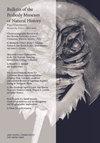A New Species of Logperch Endemic to Tennessee (Percidae: Etheostomatinae: Percina)
IF 0.9
4区 哲学
Q2 BIODIVERSITY CONSERVATION
引用次数: 9
Abstract
Abstract Percina apina, the Tennessee Logperch, is described as a new species endemic to Tennessee and distributed in the Duck River system and Whiteoak Creek. The earliest collection records for Percina apina date to 1971 and the species was identified as Percina burtoni, the Blotchside Logperch. A phylogenetic analysis of mitochondrial DNA (mtDNA) published in 2006 showed that populations identified as Percina burtoni in the Duck River system and Whiteoak Creek were a new and undescribed species. In this study, we test the hypothesis that Percina burtoni is composed of multiple species through analyses of mtDNA, nuclear genetic variation, and traditional meristic trait morphology. Our analyses of morphological divergence, nuclear genotypes, mtDNA gene trees, and comparisons with other sister species pairs of logperches confirm the distinctiveness of Percina apina. Morphologically, Percina apina is distinguished from Percina burtoni through higher average numbers of lateral line scales (93.1 versus 89.9); pored lateral line scales (91.6 versus 88.8); rows of transverse scales (38.1 versus 33.6); and scales around the caudal peduncle (36.2 versus 33.5). The two species also differ in patterns of pigmentation; the lateral blotches in Percina apina are typically wider than high, whereas the blotches tend to be higher than wide in Percina burtoni. We recommend that future species descriptions of North American freshwater fishes leverage available genetic resources and include molecular phylogenetic assessments in analyses of taxon distinctiveness. In addition, we advocate the deposition of morphological data used in species descriptions to online data repositories to ensure that other researchers are able to evaluate and modify hypotheses of species delimitations.美国田纳西州特有的一个新物种(河鲈科:土齿目:河鲈亚目)
摘要:美国田纳西州红鲈(perina apina)是美国田纳西州特有的一种新种,主要分布于鸭河水系和白栎溪。最早的收集记录可追溯到1971年,该物种被确定为斑点边鲈鱼(Blotchside log鲈)。2006年发表的线粒体DNA (mtDNA)系统发育分析表明,鸭河水系和白栎溪中被鉴定为burtoni的种群是一个未被描述的新物种。本研究通过mtDNA分析、核遗传变异分析和传统分生性状形态分析,验证了波氏斑蝽是由多物种组成的假说。通过形态学差异分析、核基因型分析、mtDNA基因树分析以及与其它亲缘种对的比较,证实了其独特性。从形态学上看,尖刺刺鱼与白刺刺鱼的侧线鳞片平均数目较高(93.1比89.9);多孔侧线鳞片(91.6比88.8);横向鳞片行数(38.1对33.6);尾柄周围的鳞片(36.2比33.5)。这两个物种在色素沉着的模式上也不同;尖刺鲷的侧斑通常宽而高,而白刺鲷的侧斑往往高而宽。我们建议未来对北美淡水鱼类的物种描述应充分利用现有的遗传资源,并在分类群独特性分析中纳入分子系统发育评估。此外,我们提倡将物种描述中使用的形态学数据存储到在线数据库中,以确保其他研究人员能够评估和修改物种划分的假设。
本文章由计算机程序翻译,如有差异,请以英文原文为准。
求助全文
约1分钟内获得全文
求助全文
来源期刊

Bulletin of the Peabody Museum of Natural History
BIODIVERSITY CONSERVATION-ECOLOGY
CiteScore
2.40
自引率
0.00%
发文量
6
审稿时长
>12 weeks
期刊介绍:
The Bulletin of the Peabody Museum of Natural History publishes original research based on specimens, artifacts and related materials maintained in the collections of the Yale Peabody Museum of Natural History’s curatorial divisions. The Bulletin is published twice a year, in April and October.
 求助内容:
求助内容: 应助结果提醒方式:
应助结果提醒方式:


